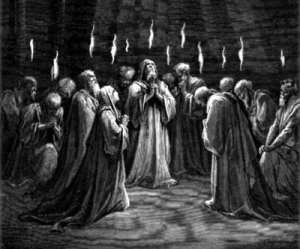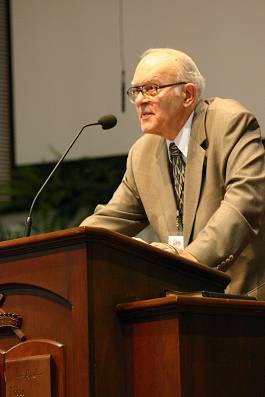1 When the day of Pentecost arrived, they were all together in one place. 2 And suddenly there came from heaven a sound like a mighty rushing wind, and it filled the entire house where they were sitting. 3 And divided tongues as of fire appeared to them and rested on each one of them. 4 And they were all filled with the Holy Spirit and began to speak in other tongues as the Spirit gave them utterance. 5 Now there were dwelling in Jerusalem Jews, devout men from every nation under heaven. 6 And at this sound the multitude came together, and they were bewildered, because each one was hearing them speak in his own language. 7 And they were amazed and astonished, saying, “Are not all these who are speaking Galileans? 8 And how is it that we hear, each of us in his own native language? 9 Parthians and Medes and Elamites and residents of Mesopotamia, Judea and Cappadocia, Pontus and Asia, 10 Phrygia and Pamphylia, Egypt and the parts of Libya belonging to Cyrene, and visitors from Rome, 11 both Jews and proselytes, Cretans and Arabians—we hear them telling in our own tongues the mighty works of God.” 12 And all were amazed and perplexed, saying to one another, “What does this mean?” 13 But others mocking said, “They are filled with new wine.”
Have you ever heard of xenoglossy? Xenoglossy is the phenomenon in which a person wakes up from a coma or emerges from some traumatic experience speaking a foreign language. It is somewhat akin to Foreign Accent Syndrome, or FAS, accept that FAS involves a person suddenly having a thick foreign accent that they somehow cannot turn off. (Think, for instance, of Madonna and the strange British accent she developed upon moving to England. I jest.)
Xenoglossy is apparently a disputed phenomenon, with many doctors questioning if it is even real. Even so, for those who claim to be suffering from it, it appears to be real enough. It would indeed be a strange phenomenon, would it not, to wake up speaking a foreign language?
Interestingly, the Wikipedia article on xenoglossy lists our text as an early example.[1] Of course, the New Testament sees what happened at Pentecost as something else entirely. In the scriptures, this is not a freak occurrence resulting from trauma or other mysterious causes. Rather, it is the deliberate act of God, granted at just the right moment and for very specific reasons. This miraculous and astounding visitation of the Spirit was foretold by Jesus and had the worldwide proclamation of the gospel of Christ as its aim. As such, it has distinctly theological, not neurological, overtones.
To get at the events described by Luke in Acts 2:1-13, let us construct a sentence. Our sentence will have three parts, each highlighting an aspect of this miraculous display.
The Church is a God-empowered body…
We will begin our sentence like this: “The Church is a God-empowered body…” Whatever else is happening here, it is clear that God is visiting His people in power. This is more than evident in the vivid imagery of our passage.
1 When the day of Pentecost arrived, they were all together in one place. 2 And suddenly there came from heaven a sound like a mighty rushing wind, and it filled the entire house where they were sitting. 3 And divided tongues as of fire appeared to them and rested on each one of them. 4a And they were all filled with the Holy Spirit
First of all, note carefully the way in which Luke describes what happened here. John Polhill explains.
Luke was well aware that he was using metaphorical language in these verses by carefully employing adverbs of comparison: “like the blowing of a violent wind”…”what seemed to be tongues” (literally “tongues as of fire,” v.3). He was dealing with the transcendent, that which is beyond the ordinary human experience and can only be expressed in earthly analogies.[2]
Yes, Luke was trying to describe something that required descriptive powers that no language possesses: a movement of God. What is most telling is that he speaks of this movement in elemental terms of “wind” and “fire.” These are images that are pregnant with theological meaning.
First, Luke says that there came “a sound like a mighty rushing wind.” The word for “wind” here is pnoe, which is a form of pneuma, also the word for Spirit. Luke uses pneuma in verse 4, undoubtedly intending to create a link between the wind that fills the house and the Spirit that fills the disciples’ lives.
The Hebrew word for wind or spirit is ruach. Tellingly, we find this word at the beginning of the Bible. In Genesis 1, we read:
1 In the beginning, God created the heavens and the earth. 2 The earth was without form and void, and darkness was over the face of the deep. And the Spirit of God was hovering over the face of the waters.
Fascinating! At creation, the Spirit of God hovered “over the face of the waters” or “the deep,” bringing creation out of the void as God spoke. The Spirit, then, is the divine breath or divine wind that brings something from nothing, the Spirit of the living God that creates everything from nothing and that can make a dead heart live!
We see the same image in Ezekiel 37, when Ezekiel prophecies over the dry bones.
7 So I prophesied as I was commanded. And as I prophesied, there was a sound, and behold, a rattling, and the bones came together, bone to its bone. 8 And I looked, and behold, there were sinews on them, and flesh had come upon them, and skin had covered them. But there was no breath in them. 9 Then he said to me, “Prophesy to the breath; prophesy, son of man, and say to the breath, Thus says the Lord God: Come from the four winds, O breath, and breathe on these slain, that they may live.” 10 So I prophesied as he commanded me, and the breath came into them, and they lived and stood on their feet, an exceedingly great army.
Here again we see the animating, empowering, enlivening Spirit of God bringing energy and vitality and life to that which previously had been still and dormant and inactive and dead. This is what the Spirit does to the unregenerate heart: it resurrects it, bringing life into its otherwise dead chambers. The wind that fills the house is the Spirit that fills the heart!
Then we see tongues as of flame descending. This image of divine fire is likewise filled with provocative theological imagery. You will recall that the Lord appeared before His people in the wilderness as a pillar of fire in Exodus 13.
17 When Pharaoh let the people go, God did not lead them by way of the land of the Philistines, although that was near. For God said, “Lest the people change their minds when they see war and return to Egypt.” 18 But God led the people around by the way of the wilderness toward the Red Sea. And the people of Israel went up out of the land of Egypt equipped for battle. 19 Moses took the bones of Joseph with him, for Joseph had made the sons of Israel solemnly swear, saying, “God will surely visit you, and you shall carry up my bones with you from here.” 20 And they moved on from Succoth and encamped at Etham, on the edge of the wilderness. 21 And the Lord went before them by day in a pillar of cloud to lead them along the way, and by night in a pillar of fire to give them light, that they might travel by day and by night. 22 The pillar of cloud by day and the pillar of fire by night did not depart from before the people.
God goes as fire before His people. Furthermore, at the baptism of Jesus, John the Baptist foretold that Christ would one day baptize His followers with fire. Interestingly, John says this in Luke’s gospel in Luke 3.
15 As the people were in expectation, and all were questioning in their hearts concerning John, whether he might be the Christ, 16 John answered them all, saying, “I baptize you with water, but he who is mightier than I is coming, the strap of whose sandals I am not worthy to untie. He will baptize you with the Holy Spirit and fire.
Here the two images are combined: wind and fire. Both bespeak the mighty movement of a holy God in and among His people. A Christian prayer from the 9th century says this:
Come, Holy Ghost, Creator blest,
Vouchsafe within our souls to rest.
Come with thy power and heavenly aid,
And fill the hearts which thou hast made.[3]
The Church is a God-empowered body! He has come to His people!
…of worldwide Jesus proclaimers…
The Church is a God-empowered body of worldwide Jesus proclaimers. The holy fire of God falls upon the Church and it falls for a particular purpose.
4 And they were all filled with the Holy Spirit and began to speak in other tongues as the Spirit gave them utterance. 5 Now there were dwelling in Jerusalem Jews, devout men from every nation under heaven. 6 And at this sound the multitude came together, and they were bewildered, because each one was hearing them speak in his own language.
Fire falls, and, significantly, it falls in the shape of tongues…and the tongues of the gathered Church are loosed with bold proclamation about the greatness of God in Christ. Fire falls, and the Church speaks!
Throughout human history, one of the most shocking, brutal, and violent acts that a person or group of people would commit against another person whose words they found offensive or dangerous was the act of violence against that person’s actual tongue. Consider Giordano Bruno, who was accused of writing heretical tracts at the close of the 17th century. On February 17, 1600, Giordano Bruno was executed after being condemned to death by the Inquisitor Robert Bellarmine. As an act of mercy a pouch of gunpowder was tied around his neck before the flames were lit. His tongue was also nailed to his jaw.
Or consider Denise Stephenson. Her parents were slaves in Halifax County, Virginia. She relates the following story: “The master wouldn’t even allow the people to pray. They had to have their prayer meeting in secret. Once they saw a man praying and they nailed his tongue to a tree…Had to be careful in those times.”
Or consider Pope Leo III. Pope Leo III had his tongue cut out by an officer named Pascal.
Or what about a monk named Erluin? In 910 AD, after Erluin “suggested that his monastery return to strict observance of the Rule of St. Benedict, his fellow monks ripped out his tongue and blinded him.”[4]
What is interesting about this disturbing trend is that it is the exact tactic the devil takes when he wants to derail the Church: he seeks to remove our tongues. He does not do so, normally, by actual physical violence, but rather by tempting us to employ our tongues in the service of every topic but Christ, by silencing us on the most important issues. How unbelievable it is that the Church seems so often to remove its own tongue when it comes to proclaiming the truth of Christ!
The tragedy is further compounded by the fact that those who deny the truth are in no way silent or shy about their errors. It seems at times that the only people who will not bear witness are those who know the truth. This should not be! Commenting on our text, the 7th/8th century English Christian, the Venerable Bede, put it beautifully when he wrote:
Now the Holy Spirit appeared in fire and in tongues because all those whom he fills he makes simultaneously to burn and to speak – to burn because of him and to speak about him. And at the same time he indicated that the holy church, when it had spread to the ends of the earth, was to speak in the languages of all nations.[5]
“To burn because of him and to speak about him.” Friends, how can we be silent about our King? When the Spirit fell upon the Church at Pentecost, it fell to enable them to speak! The Polish poet Czeslaw Milosz wrote, “What is pronounced strengthens itself. What is not pronounced tends to non-existence.”[6] Would that we understood that fact: “What is not pronounced tends to non-existence.”
If Christ is real to you, you will proclaim His Kingdom! If Christ is your King, you will not be shy to speak of Him! If Christ has raised you from death to life, you will not be timid about this amazing miracle!
And to whom does the Church proclaim? To the nations! They speak in the tongues of the nations present. While the New Testament does speak of “speaking in tongues” as we traditionally think of it, that is, of speaking in unearthly languages, that does not actually appear to be what is happening here. Will Willimon explains.
It is doubtful that Luke is describing ecstatic speech here, the glossolalia of 1 Corinthians 14, because that sort of speech needed translation for anyone to understand. Judging from the discussion of glossolalia in 1 Corinthians 14, the Spirit manifested its presence in a variety of ways in Paul’s churches. Luke’s concern is with the description of a Spirit-empowered intelligible proclamation in foreign languages (2:6,8).[7]
At Pentecost, then, when the Spirit fell, He fell upon the assembled Church to empower and enable them to speak the gospel in the languages of the gathered nations. Jesus had already told them that they would be His witness “to the ends of the earth” (Acts 1:8). Now it begins. And as it began so it should continue. We should, we must continue the worldwide proclamation of the gospel!
…whose message inevitably causes people to be amazed, perplexed, or angered.
The Church is a God-empowered body of worldwide Jesus proclaimers whose message inevitably causes people to be amazed, perplexed, or angered. These are the reactions the disciples received as a result of their bold and surprising proclamation.
7 And they were amazed and astonished, saying, “Are not all these who are speaking Galileans? 8 And how is it that we hear, each of us in his own native language? 9 Parthians and Medes and Elamites and residents of Mesopotamia, Judea and Cappadocia, Pontus and Asia, 10 Phrygia and Pamphylia, Egypt and the parts of Libya belonging to Cyrene, and visitors from Rome, 11 both Jews and proselytes, Cretans and Arabians—we hear them telling in our own tongues the mighty works of God.” 12 And all were amazed and perplexed, saying to one another, “What does this mean?” 13 But others mocking said, “They are filled with new wine.”
Let us be clear: wherever the gospel is truly proclaimed, people will respond by being amazed, by being perplexed, or by being angered. The reactions of the crowd were not all of one type then and they are not all of one type now. Then, as now, the reactions are diverse. Some believe. Some are confused. Some mock, accusing the disciples of being drunk.
What is significant is the fact that the early Church was too struck by the beauty of the message and the privilege of being able to proclaim it to worry about the divers responses of the crowd upon hearing it. Their task was to speak, not to worry about the reactions of those to whom they spoke. They clearly wanted all to believe, but the fact that many would not believe did not dissuade them. They were a people on fire, a people on fire with holy fire. Tongues of flame had taken up residence in and among them. The incendiary message of the gospel was their message because it was God’s message, and they were God’s!
Church, when we read of this amazing miracle and hold it up against our current practice and our current witness, how stark is the contrast? The God of 1st century Pentecost is the God of 21st century Central Baptist Church. If you have come to Christ, He has poured His Spirit out upon you. If the Spirit caused the early Church to speak with passion and boldness of Christ, how can He, who does not change, not cause us to do the same?
Brothers, if we do not speak, we achieve our silence only by fighting against the Spirit’s desire to be heard! If we are quiet in the face of the watching world, it is to our shame. The Spirit is a proclaiming, revealing Spirit. He bears witness to Christ. This means that if this Spirit takes up residence in the repentant, believing hearts of Christ’s Church, the Church must do what the Spirit does….and He has! He has taken up residence within us!
Church: speak!
Church: speak!!
[1] https://en.wikipedia.org/wiki/Xenoglossy
[2] John B. Polhill, Acts. The New American Commentary. Vol.26. David Dockery, gen. ed. (Nashville, TN: Broadman Press, 1992), p.98.
[3] Jaroslav Pelikan, Acts. Brazos Theological Commentary on the Bible. (Grand Rapids, MI: Brazos Press, 2005), p.50.
[4] https://www.biographybase.com/biography /Bruno_Giordano.html / https://books.google.com/books?id=4CSCw1gc_XcC&pg= PA51&lpg =PA51&dq= %22nailed+his+tongue%22&source=web&ots=2OdB7722Dv&sig= L4av RRhkeh LN8KQCwsVqtosbCsk#PPA51,M1 / https://books.google.com/books?id=xgJHI0B4oVMC&pg=RA11-PR7&lpg=RA11-PR7&dq=%22 cut+out+ his+tongue%22&source=web&ots=mP0JzYuN9V&sig=PBQ6vA5tlg9w1tSHZg-5TPwAo5k#PRA11-PR7,M1 / https://www.latinmassmagazine.com/articles/articles_2001_FA_Woods.html
[5] Francis Martin, ed. Acts. Ancient Christian Commentary on Scripture. New Testament, vol.V. Thomas C. Oden, gen. ed. (Downers Grove, IL: InterVarsity Press, 2006), p.22.
[6] “The Church’s Way of Speaking”, https://www.firstthings.com/article.php3? id_article= 224&var_recherche=tongue
[7] William H. Willimon, Acts. Interpretation. (Louisville, KY: John Knox Press, 1988), p.32.



